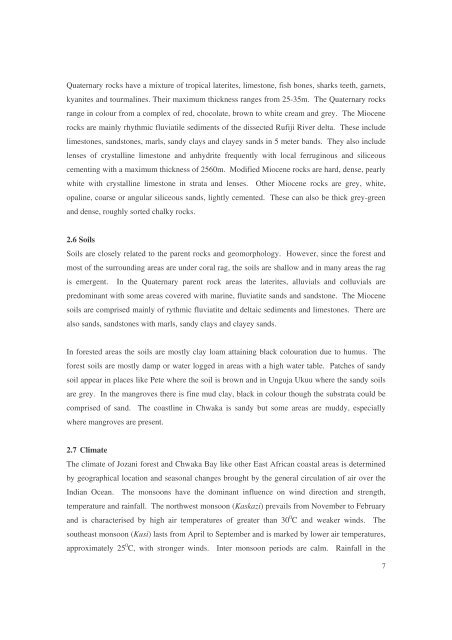Jozani biodiversity inventory report 2002 - Coastal Forests of Kenya ...
Jozani biodiversity inventory report 2002 - Coastal Forests of Kenya ...
Jozani biodiversity inventory report 2002 - Coastal Forests of Kenya ...
You also want an ePaper? Increase the reach of your titles
YUMPU automatically turns print PDFs into web optimized ePapers that Google loves.
Quaternary rocks have a mixture <strong>of</strong> tropical laterites, limestone, fish bones, sharks teeth, garnets,<br />
kyanites and tourmalines. Their maximum thickness ranges from 25-35m. The Quaternary rocks<br />
range in colour from a complex <strong>of</strong> red, chocolate, brown to white cream and grey. The Miocene<br />
rocks are mainly rhythmic fluviatile sediments <strong>of</strong> the dissected Rufiji River delta. These include<br />
limestones, sandstones, marls, sandy clays and clayey sands in 5 meter bands. They also include<br />
lenses <strong>of</strong> crystalline limestone and anhydrite frequently with local ferruginous and siliceous<br />
cementing with a maximum thickness <strong>of</strong> 2560m. Modified Miocene rocks are hard, dense, pearly<br />
white with crystalline limestone in strata and lenses. Other Miocene rocks are grey, white,<br />
opaline, coarse or angular siliceous sands, lightly cemented. These can also be thick grey-green<br />
and dense, roughly sorted chalky rocks.<br />
2.6 Soils<br />
Soils are closely related to the parent rocks and geomorphology. However, since the forest and<br />
most <strong>of</strong> the surrounding areas are under coral rag, the soils are shallow and in many areas the rag<br />
is emergent. In the Quaternary parent rock areas the laterites, alluvials and colluvials are<br />
predominant with some areas covered with marine, fluviatite sands and sandstone. The Miocene<br />
soils are comprised mainly <strong>of</strong> rythmic fluviatite and deltaic sediments and limestones. There are<br />
also sands, sandstones with marls, sandy clays and clayey sands.<br />
In forested areas the soils are mostly clay loam attaining black colouration due to humus. The<br />
forest soils are mostly damp or water logged in areas with a high water table. Patches <strong>of</strong> sandy<br />
soil appear in places like Pete where the soil is brown and in Unguja Ukuu where the sandy soils<br />
are grey. In the mangroves there is fine mud clay, black in colour though the substrata could be<br />
comprised <strong>of</strong> sand. The coastline in Chwaka is sandy but some areas are muddy, especially<br />
where mangroves are present.<br />
2.7 Climate<br />
The climate <strong>of</strong> <strong>Jozani</strong> forest and Chwaka Bay like other East African coastal areas is determined<br />
by geographical location and seasonal changes brought by the general circulation <strong>of</strong> air over the<br />
Indian Ocean. The monsoons have the dominant influence on wind direction and strength,<br />
temperature and rainfall. The northwest monsoon (Kaskazi) prevails from November to February<br />
and is characterised by high air temperatures <strong>of</strong> greater than 30 0 C and weaker winds. The<br />
southeast monsoon (Kusi) lasts from April to September and is marked by lower air temperatures,<br />
approximately 25 0 C, with stronger winds. Inter monsoon periods are calm. Rainfall in the<br />
7
















